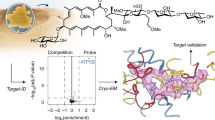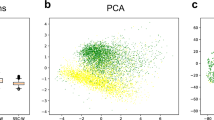Abstract
Apoptosis plays a pivotal role in the etiology or pathogenesis of numerous medical disorders, and thus, targeting of apoptotic cells may substantially advance patient care. In our quest for novel low-molecular-weight probes for apoptosis, we focused on the uncommon amino acid γ-carboxyglutamic acid (Gla), which plays a vital role in the binding of clotting factors to negatively charged phospholipid surfaces. Based on the alkyl-malonic acid motif of Gla, we have developed and now present ML-10 (2-(5-fluoro-pentyl)-2-methyl-malonic acid, MW=206 Da), the prototypical member of a novel family of small-molecule detectors of apoptosis. ML-10 was found to perform selective uptake and accumulation in apoptotic cells, while being excluded from either viable or necrotic cells. ML-10 uptake correlates with the apoptotic hallmarks of caspase activation, Annexin-V binding and disruption of mitochondrial membrane potential. The malonate moiety was found to be crucial for ML-10 function in apoptosis detection. ML-10 responds to a unique complex of features of the cell in early apoptosis, comprising irreversible loss of membrane potential, permanent acidification of cell membrane and cytoplasm, and preservation of membrane integrity. ML-10 is therefore the most compact apoptosis probe known to date. Due to its fluorine atom, ML-10 is amenable to radio-labeling with the 18F isotope, towards its potential future use for clinical positron emission tomography imaging of apoptosis.
Similar content being viewed by others
Log in or create a free account to read this content
Gain free access to this article, as well as selected content from this journal and more on nature.com
or
Abbreviations
- ML-10:
-
(2-(5-fluoro-pentyl)-2-methyl-malonic acid)
- Gla:
-
(γ-carboxyglutamic acid)
- Anti-Fas:
-
(Anti-Fas antibody)
- PMD:
-
(plasma membrane depolarization)
- pHint:
-
(intracellular pH)
- pHext:
-
(extracellular pH)
- PET:
-
(positron emission tomography)
- PS:
-
(phosphatidylserine)
- TMRE:
-
(tetramethylrhodamine-ethyl ester)
- LDH:
-
(lactate dehydrogenase)
- DDC:
-
(didansyl-L-cystine)
- HBS:
-
(Hepes buffered saline solution)
- HBSNa:
-
(HBS with 140 mM Na+)
- HBSK:
-
(HBS with 140 mM K+)
- zVAD:
-
(Z-Val-Ala-Asp-fluoromethyl ketone)
- [K+]ext:
-
(extracellular potassium concentration)
- PI:
-
(propidium iodide)
- TB:
-
(trypan blue)
References
Lahorte CM, Vanderheyden JL, Steinmetz N, Van de Wiele C, Dierckx RA, Slegers G . Apoptosis-detecting radioligands: current state of the art and future perspectives. Eur J Nucl Med Mol Imaging 2004; 31:887–919.
Wang F, Fang W, Zhao M, et al. Imaging paclitaxel (chemotherapy)-induced tumor apoptosis with (99m)Tc C2A, a domain of synaptotagmin I: a preliminary study. Nucl Med Biol 2008; 35:359–364.
Faust A, Wagner S, Law MP, et al. The nonpeptidyl caspase binding radioligand (S)-1-(4-(2-[18F]fluoroethoxy)-benzyl)-5-[1-(2-methoxymethylpyrrolidinyl)sulfonyl]isatin ([18F]CbR) as potential positron emission tomography-compatible apoptosis imaging agent. Q J Nucl Med Mol Imaging 2007; 51:67–73.
Haberkorn U, Kinscherf R, Krammer PH, Mier W, Eisenhut M . Investigation of a potential scintigraphic marker of apoptosis: radioiodinated Z-Val-Ala-DL-Asp(O-methyl)-fluoromethyl ketone. Nucl Med Biol 2001; 28:793–798.
Nelsestuen GL, Broderius M, Martin G . Role of gamma-carboxyglutamic acid. Cation specificity of prothrombin and factor X-phospholipid binding. J Biol Chem 1976; 251:6886–6893.
Hasanbasic I, Rajotte I, Blostein M . The role of gamma-carboxylation in the anti-apoptotic function of gas6. J Thromb Haemost 2005; 3:2790–2797.
Suttie JW . Mechanism of action of vitamin K: synthesis of gamma-carboxyglutamic acid. CRC Crit Rev Biochem 1980; 8:191–223.
Stirling Y . Warfarin-induced changes in procoagulant and anticoagulant proteins. Blood Coagul Fibrinol 1995; 6:361–373.
Damianovich M, Ziv I, Heyman SN, et al. ApoSense: a novel technology for functional molecular imaging of cell death in models of acute renal tubular necrosis. Eur J Nucl Med Mol Imaging 2006; 33:281–291.
Reshef A, Shirvan A, Grimberg H, et al. Novel molecular imaging of cell death in experimental cerebral stroke. Brain Res 2007; 1144:156–164.
Cohen A, Ziv I, Aloya T, et al. Monitoring of chemotherapy-induced cell death in melanoma tumors by N,N'-didansyl-L-cystine. Technol Cancer Res Treat 2007; 6:221–234.
Aloya R, Shirvan A, Grimberg H, et al. Molecular imaging of cell death in vivo by a novel small molecule probe. Apoptosis 2006; 11:2089–2101.
Nagata S, Golstein P . The Fas death factor. Science 1995; 267:1449–1456.
Graham JM, Sandall JK . Tissue-culture cell fractionation. Fractionation of membranes from tissue-culture cells homogenized by glycerol-induced lysis. Biochem J 1979; 182:157–164.
Hotchkiss RS, Chang KC, Grayson MH, et al. Adoptive transfer of apoptotic splenocytes worsens survival, whereas adoptive transfer of necrotic splenocytes improves survival in sepsis. Proc Natl Acad Sci USA 2003; 100:6724–6729.
Scaduto RC Jr, Grotyohann LW . Measurement of mitochondrial membrane potential using fluorescent rhodamine derivatives. Biophys J 1999; 76:469–477.
Bortner CD, Gomez-Angelats M, Cidlowski JA . Plasma membrane depolarization without repolarization is an early molecular event in anti-Fas-induced apoptosis. J Biol Chem 2001; 276:4304–4314.
Thompson GJ, Langlais C, Cain K, Conley EC, Cohen GM . Elevated extracellular [K+] inhibits death-receptor- and chemical-mediated apoptosis prior to caspase activation and cytochrome c release. Biochem J 2001; 357:137–145.
Lagadic-Gossmann D, Huc L, Lecureur V . Alterations of intracellular pH homeostasis in apoptosis: origins and roles. Cell Death Differ 2004; 11:953–961.
Gottlieb RA, Nordberg J, Skowronski E, Babior BM . Apoptosis induced in Jurkat cells by several agents is preceded by intracellular acidification. Proc Natl Acad Sci USA 1996; 93:654–658.
Roos A, Boron WF . Intracellular pH. Physiol Rev 1981; 61:296–434.
Appelt U, Sheriff A, Gaipl US, Kalden JR, Voll RE, Herrmann M . Viable, apoptotic and necrotic monocytes expose phosphatidylserine: cooperative binding of the ligand Annexin V to dying but not viable cells and implications for PS-dependent clearance. Cell Death Differ 2005; 12:194–196.
Flewelling RF, Hubbell WL . The membrane dipole potential in a total membrane potential model. Applications to hydrophobic ion interactions with membranes. Biophys J 1986; 49:541–552.
Franklin JC, Cafiso DS . Internal electrostatic potentials in bilayers: measuring and controlling dipole potentials in lipid vesicles. Biophys J 1993; 65:289–299.
Schamberger J, Clarke RJ . Hydrophobic ion hydration and the magnitude of the dipole potential. Biophys J 2002; 82:3081–3088.
Smith RM, Martell AE . Critical stability constants. Vol 6, Suppl 2. New York and London: Plenum Press, 1984:328–333.
Haines TH . Anionic lipid headgroups as a proton-conducting pathway along the surface of membranes: a hypothesis. Proc Natl Acad Sci USA 1983; 80:160–164.
Franco R, Bortner CD, Cidlowski JA . Potential roles of electrogenic ion transport and plasma membrane depolarization in apoptosis. J Membr Biol 2006; 209:43–58.
Jentsch TJ, Stein V, Weinreich F, Zdebik AA . Molecular structure and physiological function of chloride channels. Physiol Rev 2002; 82:503–568.
Halestrap AP, Price NT . The proton-linked monocarboxylate transporter (MCT) family: structure, function and regulation. Biochem J 1999; 343 Part 2:281–299.
Pajor AM . Molecular properties of sodium/dicarboxylate cotransporters. J Membr Biol 2000; 175:1–8.
Acknowledgements
We would like to thank Julia Dick and Mirit Argov from Aposense Ltd., for technical assistance. ML-10 is an investigational agent, developed by Aposense Ltd. (previously NeuroSurvival Technologies (NST) Ltd.).
Author information
Authors and Affiliations
Corresponding author
Rights and permissions
About this article
Cite this article
Cohen, A., Shirvan, A., Levin, G. et al. From the Gla domain to a novel small-molecule detector of apoptosis. Cell Res 19, 625–637 (2009). https://doi.org/10.1038/cr.2009.17
Received:
Revised:
Accepted:
Published:
Issue date:
DOI: https://doi.org/10.1038/cr.2009.17
Keywords
This article is cited by
-
Detection of apoptosis by [18F]ML-10 after cardiac ischemia–reperfusion injury in mice
Annals of Nuclear Medicine (2023)
-
Detection of cardiac apoptosis by [18F]ML-10 in a mouse model of permanent LAD ligation
Molecular Imaging and Biology (2022)
-
[18F]ML-10 PET imaging fails to assess early response to neoadjuvant chemotherapy in a preclinical model of triple negative breast cancer
EJNMMI Research (2020)
-
Predictive Value of [18F]ML-10 PET/CT in Early Response Evaluation of Combination Radiotherapy with Cetuximab on Nasopharyngeal Carcinoma
Molecular Imaging and Biology (2019)
-
PET imaging of cardiomyocyte apoptosis in a rat myocardial infarction model
Apoptosis (2018)



